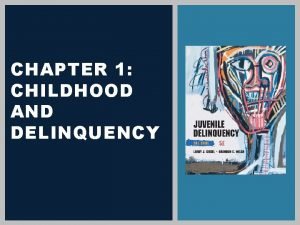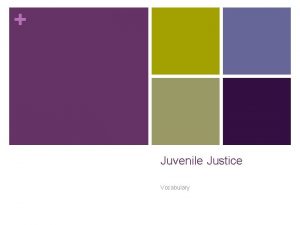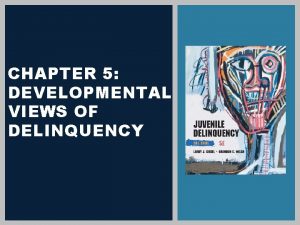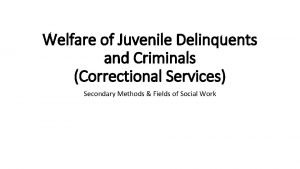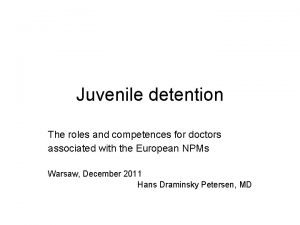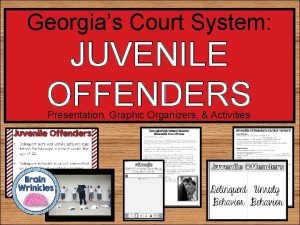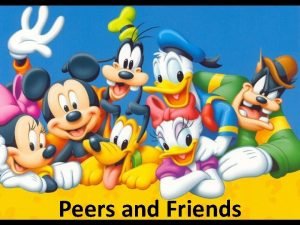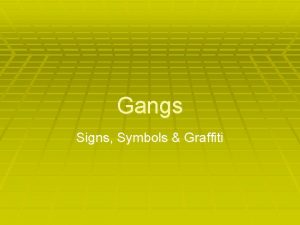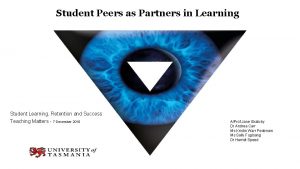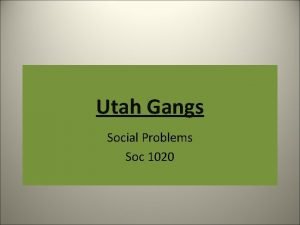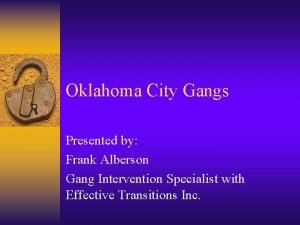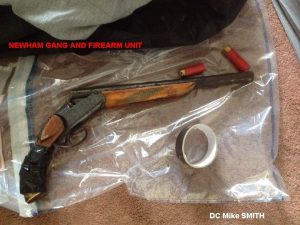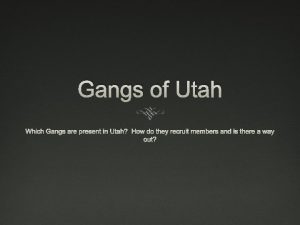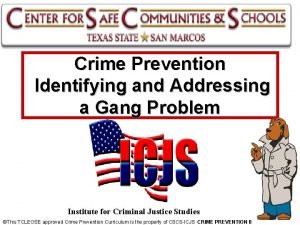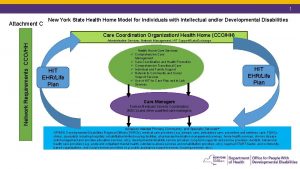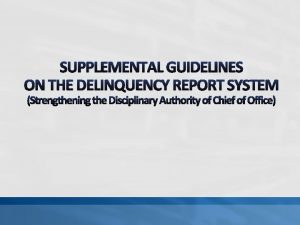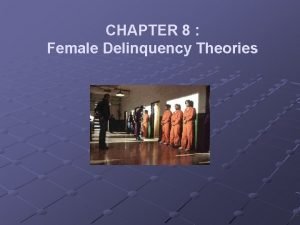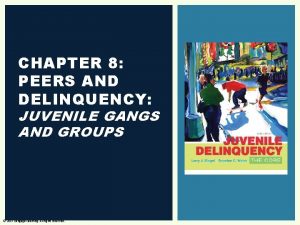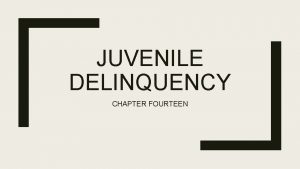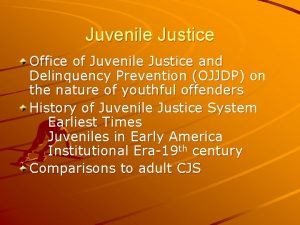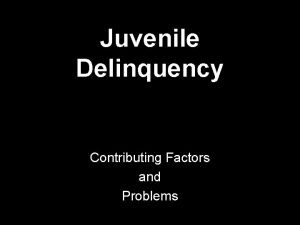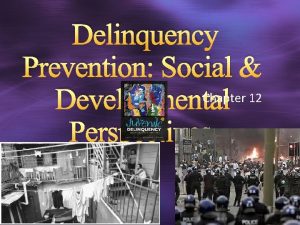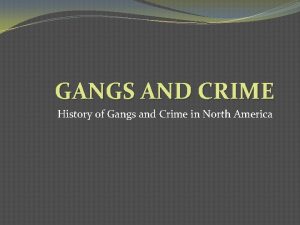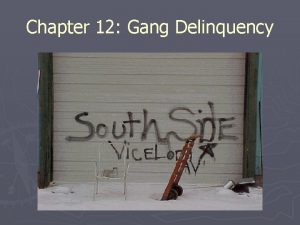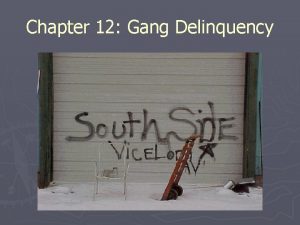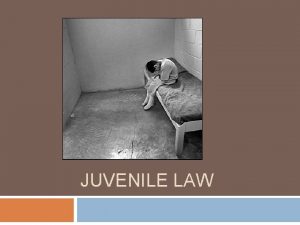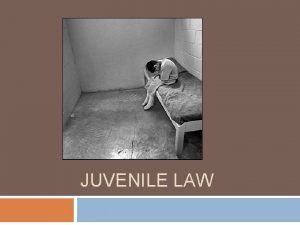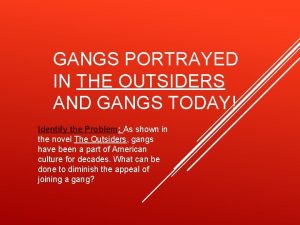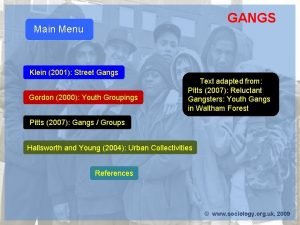CHAPTER 8 PEERS AND DELINQUENCY JUVENILE GANGS AND







































- Slides: 39

CHAPTER 8: PEERS AND DELINQUENCY: JUVENILE GANGS AND GROUPS

LEARNING OBJECTIVES After reading this chapter, students should: 1. Be familiar with the influence of peers on delinquency 2. Know the various definitions used to describe gangs 3. Describe the makeup of gangs. 4. Compare the various theories of gang formation 5. Describe the various forms of gang-control efforts that are in use today

ADOLESCENT PEER RELATIONS § Parents are the primary source of influence in early years § Between ages 8 and 14, children typically begin to seek out a stable peer group § Friends have a greater influence than parents over decision making § Children form cliques § Small groups of friends who share intimate knowledge and confidences § Also belong to crowds § Loosely organized groups who share interests and activities § Adolescent self-image is formed by perceptions of one’s place in the social world

ADOLESCENT PEER RELATIONS § Acceptance by peers: § Has a major impact on socialization § Close affiliation with a high-status peer crowd protects against depression and other negative psychological symptoms § Poor peer relations: § Related to high social anxiety § Types of Friends: § Controversial status youth § Aggressive kids who are either highly liked or intensely disliked by their peers § This sort of youth is most likely to engage in antisocial behavior

PEER RELATIONS AND DELINQUENCY § Research shows that peer group relationships are closely tied to delinquent behavior § Co-offending § Delinquent acts tend to be committed in small groups rather than alone § Adolescents who maintain delinquent friends are more likely to engage in antisocial behavior and drug use

QUESTION 1. A clique is defined as: a. b. c. d. loosely organized groups of children who share interests and activities small groups of friends who engage in crime and use drugs and alcohol small groups of friends who share activities and confidences large hoards of youths who share common locations like schools and neighborhoods

THE DIRECTION OF PEER INFLUENCE § Do antisocial peers cause delinquency or do antisocial youths seek delinquent friends? § According to control theory: § Antisocial adolescents seek out like-minded peers for criminal association and to conduct criminal transactions § According to labeling theory : § Deviant kids are forced to choose deviant peers § According to social learning theory: § Delinquent friends cause law-abiding youth to get in trouble § According to routine activities: § Kids with like-minded peers without parental control are more likely to be involved in delinquency

QUESTION 2. Co-offending is defined as: a. b. c. d. the tendency for youths to commit 2 or more delinquent acts rather than a single act the tendency for youths to use drugs or alcohol when they commit delinquent acts the tendency to commit delinquent acts in small groups rather than alone the tendency for youths to commit delinquent acts when with older youths

Definition of A Gang? • An association of peers, bound together by mutual interests, with identifiable leadership, well-developed lines of authority, and other organizational features, who act in concert to achieve a specific purpose or purposes, which generally include the control over a particular territory, facility, or type of enterprise. Could this not define a police department or any other organization for that matter?

Walter Miller’s Definition of A Gang § A youth gang is a self-forming association of peers, bound together by mutual interests, with identifiable leadership, well-developed lines of authority, and other organizational features, who act in concert to achieve a specific purpose or purposes, which generally include the conduct of illegal activity and control over a particular territory, facility, or type of enterprise.

YOUTH GANGS § A gang is a group of youths who collectively engage in delinquent behaviors § Gang Expert Malcolm Klein argues that two factors stand out in all definitions ① Members have self recognition of their gang status and special vocabulary, clothing, signs, colors, graffiti, and names ② There is a commitment to criminal activity

YOUTH GANGS § The National Gang Center Uses these defining factors: ① The group has three or more members, generally aging from 12 to 24 ② Members share an identity, typically linked to a name and often other symbols ③ Members view themselves as a gang, and are recognized by others as a gang ④ The group has some permanence and a degree of organization ⑤ The group is involved in an elevated level of criminal activity

GANG COLORS BY NATION


CONTEMPORARY GANGS § According to National Youth Gang Survey (NYGS): § A significant majority of urban areas report the presence of gangs, and gangs exist in all level of the social strata § An estimated 27, 000 gangs containing about 800, 000 gang members were active in the United States § Traditionally operate in disorganized neighborhoods experiencing rapid population change – “transitional neighborhoods” § While gangs are disproportionately located in urban areas, thousands of gangs are located in small cities, suburban counties, and even rural areas § Migration: § NYGS found many jurisdictions have experienced gang migration, and in a few areas more than half of all gang members had come from other areas

Youth Gang Migration – Current Example Ø According to NYGS (2010), 65% of rural areas and 74% of urban areas reported increased gang migration. There are two reasons for migration: ① Illegitimate reasons, such as drug distribution and other illegal activities, recruiting members, and avoiding law enforcement, and ② Legitimate or “social” reasons, such as family moves and relocating for job opportunities. According to the report, social reasons outweighed illegitimate reasons as the lead factors for gang-member migration Ø What impact, if any, do you think gang migration has on local law enforcement and local community? Ø What can rural communities and law enforcement do when they experience an influx of gang activity? Ø Should they draw upon the experience of urban areas who are experienced in dealing with gang problems, or is there a particular way rural areas should deal the issue?

Today’s Gangs § Age § Ranges widely (ages 8 to 55), and average is increasing § Gender § Traditionally male, 1/3 are females, gender-mixed gangs are more common § Females in all or majority-female gangs with lowest delinquency rate § Leadership § Delinquent gangs tend to be small and transitory § Youths often belong to more than a single group or clique and develop an extensive network of delinquent associates § Communication § Gangs seek recognition, both from their rivals and from the community § Graffiti § Representing

QUESTION 3. An estimated 27, 000 gangs containing about _______ gang members were active in the United States, a. b. c. d. 320, 000 600, 000 800, 000 1, 200, 000

QUESTION 4. Which of the following best describes the most common reason for gang member migration in the United States? a. b. c. d. political, to spread the influence of gangs social, the gang member’s family moves economic, to spread the drug distribution network social, to spread the social networks of the gang

TYPES OF GANGS § Four Categories: ① Social Gang § Some minor drug and alcohol use; focus on social activities ② Party Gang § Focus on drug use and sales, but not other delinquent activities ③ Serious Delinquent Gang § Focus on serious delinquent activity, but not drug dealing or use ④ Organized Gang § Heavy involvement in serious delinquent behavior and violence § Just as there are different types of gangs, there also different types of roles played by gang members

GIRLS AND GANGS § Why Do Girls Join Gangs? § Financial opportunity § Identity and social status § Peer pressure § Escape turbulent family lives § Protection § National Data suggests… § About 10% of gang members are female.

QUESTION 5. A(n) _________ gang is heavily involved in criminality, particularly in drug sales and they use violence to establish control over drug sale territories. a. b. social party c. d. organized none of the above

QUESTION 6. National data indicate that about _______ percent of gang members are female. a. b. 20 15 c. d. 10 30

ETHNIC AND RACIAL COMPOSITION § African American and Latino youths predominate gang membership § 1/2 are Hispanic/Latino § 1/3 African American § 1/5 European American § Association between gang member size, gang problem onset, and race/ethnicity characteristics § Larger cities with newer gang problems are twice as likely to report greater variation in racial/ethnic composition § Ethnic distribution corresponds to geographic location

AFRICAN AMERICAN GANGS § First organized in the early 1920 s § Maintain a national presence in the U. S. : § Black P. Stone Nation: 6, 000 -8, 000 members § Bloods: 7, 000 -30, 000 members § Crips: 30, 000 -35, 000 § Unique characteristics § Nicknames § Nondescript attire § Distinctive hairstyles § Tattooing § Distinctive graffiti

LATINO GANGS § Gangs are popular in the Latino culture § Admission involves rituals that prove their machismo § Leadership hierarchy is fixed in some areas, fluid in others (Southern CA) § Known for dress code: § Tank-style t-shirts § Territory marked with colorful and intricate graffiti, stylized lettering and 3 -D designs § Strong sense of turf § Most feared Latino Gang § Mara Salvatrucha (MS-13) § This is the nation’s most dangerous gang

QUESTION 7. About half of all gangs in the U. S. are European American. a. True b. False

ASIAN GANGS § Prominent in New York, Los Angeles, San Francisco, Seattle, and Houston § Tiny Rascal Gangsters is the largest and most violent Asian gang in the U. S. § Regional gangs also operate on the west coast § Unique because they do not share qualities with other ethnically-based groups § Victimize members of their own ethnic group § More organized than other gangs, have recognizable leaders, more secretive, less territorial, and less openly visible § Milwaukee - http: //youtu. be/4 r. YL 2 Fy. LSY 4 26

Tiny Rascals Gang – Current Example Ø Tiny Rascals Gang is the largest Asian gang in the United States. It consists of both male and female members (females are known as the “Lady Rascals Gang”) with an age range of 13 -26. Its members are primarily Cambodian and Laotian. Its known criminal activities include murder, drive by shootings, robberies, narcotic violations and weapons offenses on a nationwide scale. ü Why do you think some young Asian-Americans join gangs? ü Are the reasons different from the reasons some young African-Americans, European-Americans, and Hispanics join gangs?

ANGLO GANGS § First American youth gangs were European American § Gangs Of New York § During the 1950’s they competed with African American and Latino gangs § Today they account for less than 10% of all gang members § Members are often alienated middle class youth § Today they are often referred to as skinheads, and may be identified by a shaved head and Nazi or KKK markings

GANGS AND DELINQUENCY § Members of youth gangs commit more crime than any other group of youths § Three explanations for association of gang membership and delinquency: ① Selection Hypothesis-kids with history of crime and violence join ② Facilitation Hypothesis-they join to facilitate their deviant behavior ③ Enhancement Hypothesis-selection and facilitation work interactively § Gang criminality has numerous patterns § Some gangs specialize in drug dealing, others partake in a wide variety of criminal activity

GANG VIOLENCE § Gang members are: § More violent than non-members § More likely to carry weapons § More likely to commit homicide § Violence is used to: § Transform a peer group into a gang § Maintain the gang’s internal discipline § Prestige crimes § When a gang member steals or assaults to gain prestige in the gang

The 5 US Cities with Worst Gang Violence – Current Example Ø According to the Centers for Disease Control and Prevention (2012), Long Beach, CA, Los Angeles, CA, Newark, NJ, Oakland, CA and Oklahoma City, OK, are the U. S. capitals of gang homicide. In L. A. and Long Beach, less than 5% of all homicides were associated with drug trade or use. In Oakland 12. 5% of homicides were drugrelated, and in Oklahoma City, 25. 4% of homicides were related to drugs. In Los Angeles and Long Beach, gang homicides account for the majority of homicides among 15 to 24 -year-olds: 61 and 69%, respectively. ü Why do you think gangs are involved in so much violence? ü What impact does gang violence have in our communities? ü What can be done to reduce gang violence? ü What can be done to discourage youths from joining gangs? ü Do you think if less teens joined gangs, overall gang member ship would decline? Why or why not?

WHY DO YOUTHS JOIN GANGS? § Anthropological View § Appeal to tribal instincts § Social Disorganization/Sociocultural View § Youth gangs form due to destructive sociocultural forces in disorganized areas § Anomie/Alienation View § Alienation leads to gang involvement § Social conditions encourage gang activity

WHY DO YOUTHS JOIN GANGS? § Psychological View § Youth with antisocial personality defect are the most likely group to join gangs § Rational Choice View § Youths join to obtain desired goods and services § i. e. illegal drugs § Personal safety § Fun and support

QUESTION 8. According to the ________ view, gangs appeal to adolescents’ longing for the tribal process that sustained their ancestors. a. b. c. d. liberation social injury rational choice anthropological

CONTROLLING GANG ACTIVITY § Law Enforcement Efforts § Youth service programs § Gang details § Gang units § Community Control Efforts § Detached street worker § Gang outreach § Homeboy Industries, Inc. § Recreation

WHY GANG CONTROL IS DIFFICULT § Aggressive tactics can be overzealous and alienate the community § Social and economic solutions seem equally challenging § It is a socio-ecological phenomenon, requiring social solutions that do not have an easy fix

SUMMARY ü Peers influence delinquency ü Different views on association between peers and delinquency exist ü Historical development of gangs ü Recognize the extent and location of gang problem ü Know the roles of females in gangs ü Racial and ethnic makeup of gangs differs ü Understand gang criminality ü Know theories of gang formation ü Be familiar with gang control strategies
 Nature and extent of juvenile delinquency
Nature and extent of juvenile delinquency Poverty and juvenile delinquency
Poverty and juvenile delinquency According to choice theorists, offenders
According to choice theorists, offenders Juvenile delinquency objectives
Juvenile delinquency objectives Juvenile delinquency vocabulary words
Juvenile delinquency vocabulary words Newspaper article on juvenile delinquency
Newspaper article on juvenile delinquency Developmental theory juvenile delinquency
Developmental theory juvenile delinquency Categories of delinquent youth
Categories of delinquent youth Treatment of juvenile delinquency
Treatment of juvenile delinquency Management of juvenile delinquency
Management of juvenile delinquency Juvenile delinquency graphic organizer
Juvenile delinquency graphic organizer Peers and friend
Peers and friend This is an informal language used by peers and friends
This is an informal language used by peers and friends Formal language
Formal language Gang sign letters
Gang sign letters Dun and bradstreet delinquency predictor score
Dun and bradstreet delinquency predictor score Peers for hope house
Peers for hope house Maksud peer coaching
Maksud peer coaching Connected peers meaning
Connected peers meaning Setting of a jury of her peers
Setting of a jury of her peers Kurt vonnegut socialism
Kurt vonnegut socialism Peer coaching plc
Peer coaching plc Peers as partners in learning
Peers as partners in learning Ciri-ciri coaching
Ciri-ciri coaching Pieter peers
Pieter peers Peers goals
Peers goals Mary peers
Mary peers Tracy david swena
Tracy david swena Tu cliques
Tu cliques Los carnales pueblo menu
Los carnales pueblo menu Oklahoma south side locos
Oklahoma south side locos Victorian london gangs
Victorian london gangs Blackwater london gang
Blackwater london gang Surenos in utah
Surenos in utah Gangs
Gangs Gangs of new york cda
Gangs of new york cda Pnp delinquency report system
Pnp delinquency report system Delinquency management in microfinance
Delinquency management in microfinance Female delinquency theories
Female delinquency theories What is a good delinquency predictor score
What is a good delinquency predictor score



